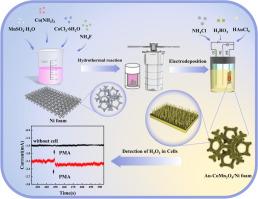自支撑Au-CoMn2O4 /Ni泡沫异质结构传感器,用于高效H2O2检测和实时肿瘤生物标志物监测
IF 5.6
3区 材料科学
Q1 ELECTROCHEMISTRY
引用次数: 0
摘要
过氧化氢(H₂O₂)是一种重要的氧化应激生物标志物,与多种疾病有关,特别是肿瘤进展和炎症性疾病。准确监测H₂O₂对于了解疾病发展过程中涉及的微环境动力学至关重要。然而,传统的金属氧化物电化学传感器存在催化效率低、纳米颗粒聚集等问题。在此,我们报告了一种基于合理设计的au - com₂O₄/Ni泡沫异质结构的高性能,无粘结剂的h2o₂O₂传感器。这种集成架构利用导电3D Ni泡沫和界面介导的相互作用增强的电荷转移界面来显着提高传感性能。该传感器具有3100.04 μA·mM⁻¹·cm⁻²(2 - 666 μM)和821.41 μA·mM⁻¹·cm⁻²(1.066-22.166 mM)两种灵敏度,超低检测限为0.036 μM,线性检测范围为2 μM - 22.166 mM (R² = 0.99)。它还具有出色的选择性、长期稳定性(30天内信号衰减<;3%)和重复性(RSD≈2.5%)。值得注意的是,该传感器能够实时电化学监测A549肺癌细胞在phorbol 12-肉豆蔻酸13-乙酸酯(PMA)刺激下释放的H₂O₂,突出了其作为先进电化学传感平台的潜力。重要的是,传感机制可以通过界面结构分析和电化学验证来很好地解释,而不需要理论模拟。本文章由计算机程序翻译,如有差异,请以英文原文为准。

Self-supported Au–CoMn2O4/Ni foam heterostructure sensor for efficient H2O2 detection and real-time tumor biomarker monitoring
Hydrogen peroxide (H₂O₂) is a crucial oxidative stress biomarker associated with various diseases, especially tumor progression and inflammatory disorders. Accurate monitoring of H₂O₂ is essential for understanding the microenvironmental dynamics involved in disease development. However, traditional metal oxide-based electrochemical sensors often suffer from low catalytic efficiency and nanoparticle aggregation.Herein, we report a high-performance, binder-free H₂O₂ sensor based on a rationally engineered Au–CoMn₂O₄/Ni foam heterostructure. This integrated architecture leverages the conductive 3D Ni foam and an interface-mediated interaction-enhanced charge transfer interface to significantly enhance sensing performance. The resulting sensor exhibits two sensitivities, 3100.04 μA·mM⁻¹·cm⁻² (2–666 μM) and 821.41 μA·mM⁻¹·cm⁻² (1.066–22.166 mM), an ultralow detection limit of 0.036 μM, and a practical linear detection range spanning 2 μM–22.166 mM (R² = 0.99). It also demonstrates excellent selectivity, long-term stability (<3% signal decay over 30 days), and reproducibility (RSD ≈ 2.5%). Notably, the sensor enables real-time electrochemical monitoring of H₂O₂ released by A549 lung cancer cells under phorbol 12-myristate 13-acetate (PMA) stimulation, highlighting its potential as a platform for advanced electrochemical sensing. Importantly, the sensing mechanism can be well interpreted via interfacial structure analysis and electrochemical validation, without requiring theoretical simulations.
求助全文
通过发布文献求助,成功后即可免费获取论文全文。
去求助
来源期刊

Electrochimica Acta
工程技术-电化学
CiteScore
11.30
自引率
6.10%
发文量
1634
审稿时长
41 days
期刊介绍:
Electrochimica Acta is an international journal. It is intended for the publication of both original work and reviews in the field of electrochemistry. Electrochemistry should be interpreted to mean any of the research fields covered by the Divisions of the International Society of Electrochemistry listed below, as well as emerging scientific domains covered by ISE New Topics Committee.
 求助内容:
求助内容: 应助结果提醒方式:
应助结果提醒方式:


